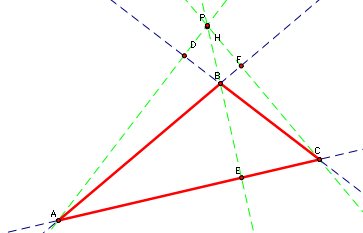
Ceva's Theorem
by Margaret Morgan


triangle ABE is similar to IPE (because IP is parallel to AB)
So, IP/AB = PE/BE
------
(5)
triangle ABD is similar to triangle LDP
So, LP/AB = PD/AD
-----
------
(7) Substituting (1) into 6, we get
AF/FB = IP/PL = (PE/BE)/(PD/AD)
AF/FB = (PE/BE)/(PD/AD) = ((PE)(AD))/((BE)(PD))
------
(8) triangle FBC is similar to triangle FGP ( because GP is parallel to BC)
So, GP/BC = PF/FC
------
(9) triangle BEC is similar to triangle PEJ (because PJ is parallel to BC).
So, PJ/BC = PE/BE
----
(10) Dividing (8) and (9), we get
(GP/BC)/(PJ/BC) = (PF/FC)/(PE/BE)
GP/PJ = ((PF)(BE))/((FC)(PE))
-----
(11)
Substituting (2) into (10) we get
BD/DC = ((PF)(BE)/(PE)(CF))
------
(12) triangle ADC is similar to triangle PDK (because PK is parallel to EC).
So PK/ AC= PD/AD
-------
(13) triangle AFC is similar to FHP (because HP is parallel to AC)
HP/ AC= PF/CF
-----
(14)
Dividing (12) and (13) we get
PK/HP = (PD/AD)/(PF/CF) = ((PD)(CF)/(PF)(AD))
------
(15)
Substituting (3) into (14) we get
CE/EA = ((PD)(CF)/(PF)(AD))
------
Multiplying (7), (11), and (15) we get
(AF/FB)(BD/DC)(CE/EA) = ((PE)(AD) (PF)(BE)(PD) (CF)) /( (BE)(PD)(PE) (CF) (PF)(AD)) = 1
So finally, we have (AF)(BD)(CE) = (FB)(DC)(EA)
Ceva's
Theorem states in a triangle ABC, three lines AD, BE and CF intersect
at a single point P if and only if
((AF)(BD)(CE))/((FB)(DC)(EA))= 1.
Proof: Argument above shows that if AD, BE, and CF intersect at a point P then the given ratio is 1.
Now, we will prove it in the other direction. Start with a triangle ABC, with points DEF such that (AF)(BD)(CE)/(FB)(DC)(EA) = 1.

Let P be the intersection of BE and FC. Draw a line From A through P until it intersects BC at point H.

Now we know, from what we just proved that
(AF)(BH)(CE)/(FB)(HC)(EA) = 1
So, (AF)(BD)(CE)/(FB)(DC)(EA) = (AF)(BH)(CE)/(FB)(HC)(EA)
Simplifying we get BD/DC = BH/HC
Now to compare the two ratios let's make both numerators the full length of BC.
BD/DC + DC/DC = BH/HC + HC/HC
This is equivalent to adding one to both sides, so we still have equality.
BC/DC = BC/HC
This can only be true if D and H are the same point.
Special Case of P:
What if D,E, and F are the midpoints of the sides of ABC?
In this case AF = FB, BD = DC, and AE = EC, so AF/FB = 1, BD/DC = 1, AE/EC = 1 and their product equals 1. Ceva's theorem tells us that the lines AD, BE, and CF must be concurrent. We call the point P in this case the centroid.
Initially, we considered only points P that lie inside the triangle ABC, but ceva's theorem holds for points P outside of triangle ABC as well. Click hear to see a GSP sketch that illustrates the theorem for any possible point P.
Seeing that the theorem holds for P outside of ABC allows us to look at another special case of P.
What if D, E, and F are the feet of the altitudes of triangle ABC?

(1)
Triangle ACD is similar to triangle BCE
<BCE = <ACD -- same angle
<BEC = <ADC -- both right angles by construction
So, <EBC = <DAC
BC/AC = BE/AD = EC/DC
-------
(2) Triangle AFC is similar to triangle EAB
<FAC = <EAB -- same angle
<AFC = BEA -- both right angles by construction
So, <ACF = < EBA
AF/EA = CF/BE = AC/AB
-----
(3) Triangle BAD is similar to triangle FBC
<ABD = <FBC -- vertical angles
<ADB = <BFC -- both right angles by construction
So, <BAD = <BCF
AD/FC = AB/BC = BD/BF
-----
Multiplying (1), (2), and (3)
AF/EA * BD/BF *EC/DC= AC/AB * AB/BC *BC/AC
(AF * BD * EC)/ (EA*BF *DC) = 1
Now, by Ceva's theorems the lines are concurrent. We refer to the point p as the orthocenter.